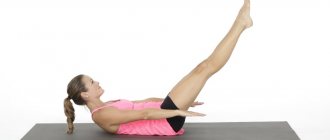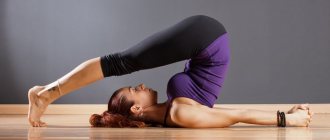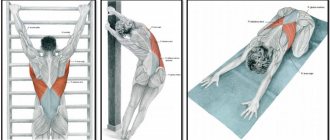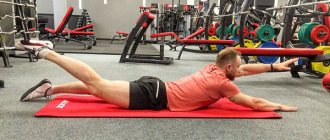Stretching is something that is inherent in us by nature. If you remember the situation when, after sitting at the computer for a long time, you suddenly want to stretch, or almost the same movements in the morning, while still sitting on the edge of the bed, then this is stretching the spine at home. Of course, she is far from competent and professional. But knowing its basics and mastering the recommended exercises, you can become an expert in this without even leaving home.
For those who play sports, stretching is an integral part of training; for others, it can become part of a wellness complex.
Stretching is done:
- Before starting a workout, in order to prepare muscle groups for further loads.
- After an intense workout, to stretch overworked muscles and eliminate “clogs.”
- As a separate system of exercises aimed at obtaining a specific result (to do the transverse or longitudinal splits).
Depending on the expected results, the set of stretching exercises, the intensity of their implementation and the time allotted for this change.
What is stretching
Stretching is a trend in fitness that appeared in the 50s of the 20th century, in Sweden, to develop muscle elasticity and respect for ligaments.
The name of the workout comes from the English word “stretch”. This system of exercises was developed in order to relax the muscles after exercise and prepare it before it. From playing sports, muscles receive microtraumas. To make them heal faster, you need to stretch them.
Stretching is used in:
- dancing;
- strength exercises;
- cardio training.
Stretching is an area that can be practiced at any age. To prevent muscle pain after training, it is enough to stretch for 10-15 minutes. at the beginning and end of the lesson. If the goal is to stretch the muscles as much as possible (for example, doing the splits), then you need to devote at least 2 hours a week to stretching.
Stretching should begin with a warm-up (warming up the body) so as not to injure the ligaments. During training, muscles and ligaments are stretched, relaxing the entire body. Exercises affect all muscle groups.
Basic principles:
- Stretch to the maximum, but not to the point of pain.
- Relax your whole body.
- Give elasticity to muscles and joints - mobility.
- Strengthen the muscles of the whole body.
- Keep your body in good shape.
- Regularity is the key to a plastic, flexible body.
The training may consist of exercises:
- isometric (for one muscle group);
- isotonic (for several muscle groups);
- stretching (for muscle elasticity).
All exercises involve holding in a certain position. They are selected according to their level of training. At first you may not be able to master all the positions. But with the development of flexibility, it is possible to master a pose of any complexity.
What are the benefits of stretching and flexibility exercises?
There are several reasons to include stretching in your training program:
- Strengthening joints and developing their mobility.
- Prevention of muscle and joint injuries both during training and in everyday life.
- Reducing residual tension in muscles after exercise.
- Improving blood supply to muscles, which is important both before and after training. The better your stretching, the more benefits you will get from your workouts and the better your athletic performance will be.
- With regular stretching, muscle tissue becomes thicker and smoother. This will be useful for those who are struggling for a slim and graceful body.
- Stretching affects gait and normal movements in everyday life. This aesthetic component is important for both sexes.
- Regular stretching slows down the aging of joints and reduces the risk of age-related changes.
- “Healing” old injuries. Often, constant muscle pain is caused by spasms; in these cases, due to heavy loads, the muscles contract easily, but cannot completely relax even after training. Stretching will relieve muscle spasms and the pain they cause will disappear.
The difference between stretching and other fitness systems
Stretching is a direction in fitness that is radically different from other programs because:
- Develops flexibility, stretches tendons and muscles;
- Relaxes the whole body;
- There are no restrictions on age and physical fitness;
- The whole body is involved;
- Static and smooth movements.
As you can see, this direction in fitness plays an important role. It has many benefits for humans. But it should not be confused with yoga, as this is a separate direction. Yoga focuses on the general state of a person in a particular position, deep breathing and meditation. Stretching is aimed at stretching muscles, and yoga is aimed at healing the entire body through physical and spiritual practices.
Main types
Stretching is stretching wisely. For a specific purpose, there are different types of this direction.
Stretching can be of several types:
- static;
- dynamic;
- passive;
- ballistic;
- with resistance.
The choice of the type of stretching depends on desire and the degree of physical fitness.
Passive stretching
This type of training is carried out with the help of a trainer/partner or special objects.
It consists in the fact that you need to take the necessary positions and relax. Your partner will do the stretching. There is no need to make any effort.
Stretching with resistance
Stretching with resistance is performed using an expander band. Taking any position and stretching with the expander, the tape exerts resistance. This way the muscles not only stretch, but also resist. The tension increases, the muscles contract even more.
Static stretching
This type of stretching involves stretching in a specific position. When taking it, you need to stretch as much as possible and stay at the maximum point for 30-60 seconds.
This allows you to relax and feel the muscles. It is important to breathe calmly and not cause pain.
Ballistic stretch
Ballistic stretching is active stretching. Muscle stretching occurs during sudden movements (jumping, squatting, swinging legs/arms, bending). Its goal is to increase range of motion. This allows you to deliver stronger blows, jump higher, and the range of movements also increases. This stretching technique uses all muscles to the maximum.
Ballistic stretching does not allow for relaxation and can more often lead to injury. On the contrary, it keeps the muscles tense, developing the stretch reflex.
Why and when to do stretching[edit | edit code]
Stretching lengthens muscles and makes the ligaments connecting them more elastic. Thanks to it, you will be able to move more freely and at the same time maintain the strength of your joints. Excess flexibility often leads to joint instability, and its lack leads to stiffness of movement. When your muscles are the ideal length, you move without feeling any tension. You can lean or turn back. Essentially, you can do all sorts of things that a person wouldn't normally even think about until they get into trouble. When your muscles and joints lose flexibility, you begin to constantly feel discomfort and stiffness.
In this article we explain two stretching methods: active-isolated
and
PNF stretching
. Both actively stimulate the nervous system and help relieve muscle tension. With their help, you will master the art of stretching in a shorter time than when learning traditional stretching. In addition, you will learn how to contract your muscles correctly, which will ultimately help them relax more.
Muscle lengthening[edit | edit code]
Muscle stiffness
- this is not just a consequence of tension arising in muscle tissue. For example, when a person is under anesthesia, his body is much more flexible than under normal conditions. The fact is that muscle tension in the human body is regulated by the neuromuscular system. Therefore, when doing stretching, you not only stretch the muscle fibers, but also force the nervous system to give the muscles a signal to relax at the moment when they are stretched to their maximum.
Some studies show that the optimal time to stretch a muscle is approximately 20-30 seconds. Stretching for 60 seconds will not make you more flexible. It is better to do two stretching exercises for 30 seconds each, or three stretches for 20 seconds each, than to torture a muscle for a minute. Repeated stimulation of the nervous system through stretching is thought to help lengthen muscles at rest. Research shows that after the first four repetitions there is an increase in muscle flexibility and elasticity.
Relieving muscle tension[edit | edit code]
It is important to understand that muscle relaxation occurs in a complex manner. In other words, the back of the thigh cannot exist separately from the rest of the body. For example, tension in the calves is directly related to the strength of the lower leg muscles. If the calf muscles are stronger than the calf muscles, then they dominate and you will feel tension in the calves. To reduce it, it is necessary to strengthen the muscles of the lower leg.
Stretching alone will not relieve muscle tension. This problem needs to be approached comprehensively. Your training program should consist of both strength training and stretching exercises. Remember the rule: whichever muscle we tense, the one we relax.
Injury Prevention[edit | edit code]
Stretching is widely recommended to prevent injury and relieve muscle pain. However, as observations show, traditional stretching methods may not achieve these goals and, on the contrary, may cause
injuries (For example, if you stretch too hard without warming up first, you can tear a muscle.) Scientists at the University of Hawaii studied the fitness of more than a hundred runners. It turned out that athletes who do not stretch show better results and are less prone to injuries. After running, they are less likely to complain of muscle pain than their colleagues who stretch regularly. What's the matter? Perhaps this is because tense, rather than relaxed, muscles strengthen joints better, thereby protecting the knees and hips from injury while running.
However, if the muscles are too tense, the risk of injury increases a hundredfold. For example, a runner who sits a lot during the day, thereby straining the biceps femoris muscle, is predisposed to herniated discs.
. After all, this muscle pulls the pelvic bones, moving them back. After some time, her tension forms an unnaturally straight posture. The fluid in the intervertebral disc shifts to its back, creating pressure on the spine and characteristic protrusions. However, lack of flexibility doesn't just hurt sedentary runners, as another recent study found. According to his data, for two or three days after lifting moderate weights, less flexible people feel more muscle tension than their more flexible counterparts.
And yet, do not forget that the mentioned studies are only a drop in the sea of the huge number of works devoted to this issue. It seems that some of them even appear only to prove or debunk the previous ones. You can, of course, try to figure them out, but most often they are just comparing apples with oranges.
The key to success in stretching[edit | edit code]
How to get and maintain the ideal muscle length, at which they will work easily and freely? Stretching plays an important role in achieving this goal.
We offer the following recommendations for proper stretching.
- Perform each stretch for 10 to 30 seconds and do four repetitions.
- Perform at least one stretch for each major muscle group.
- Stretching at least two or three times a week, preferably every day.
- Stretch until you feel slight discomfort, but no more.
- Don't hold your breath while stretching.
When seriously practicing stretching, it is necessary to understand one more important point, namely, its reflex mechanism
, which protects the muscle from tearing by signaling it to contract. You observed an example of the action of the reflex mechanism at an appointment with a neurologist. When the doctor hits your knee with a hammer, your leg immediately jerks in response (because your quadriceps muscle immediately contracts). To avoid stimulating the reflex mechanism, never stretch the muscle to its extreme length. And do not stretch too quickly, thereby tugging at the muscle.
Today, most studies look primarily at traditional types of stretching. However, there are some other methods (we'll talk about them a little later) that can prevent injury and relieve muscle pain. Generally speaking, there is no universal method of stretching that would be optimal for all people. After all, we all have different builds, have different experiences in sports and set completely different goals for ourselves. So experiment with different methods and find ways of stretching that are most comfortable for you. You may even want to combine several methods in one workout. For example, for a biceps femoris stretch, you might prefer the active-isolation method (described later in this chapter) or a traditional shoulder stretch.
The benefits of stretching
Stretching is very beneficial for health:
| Tones muscles and gives vitality | Stretching keeps all muscles toned, improves mood and invigorates. |
| Improves blood circulation | This promotes muscle development and faster recovery. Tightens the whole body, makes the skin elastic. |
| Improves balance | There are many exercises in stretching that require you to “spring” and maintain balance. |
| Develops flexibility, plasticity, joint mobility and muscle elasticity | This reduces the risk of injury. For older people, stretching is a great opportunity to become more mobile. |
| Develops endurance | Each exercise uses a specific muscle group, which helps you maintain the position. |
| Speeds up metabolism | It is good for health and fat burning. |
| Relaxes and sharpens the mind | Stretching teaches you to control your body: tense and relax, balance, breathe correctly. |
| Controls stress resistance | Stretching muscles helps relieve physical and mental stress. |
What is muscle stretching
It is impossible to increase flexibility and make your body beautiful in one or two workouts; regularity is required. The good news is that stretching is not time consuming and does not require a lot of space. Anyone can stretch correctly; the exercises are simple and easy to learn even at home.
The first results may appear within a week. In rare cases, it takes several months, or even a year. This does not depend on the intensity of the training; the individual characteristics of the body and physical fitness influence more. To put it simply (and a little crudely), there are “wooden” bodies. It is difficult for them to bend over and bend. But in any case, muscle stretching is necessary, and first of all for health. And it is vital for people who spend a lot of time sitting, lying or standing.
Advice! If stretching does not give any results or they are far from the desired achievements, it is recommended to reschedule the training time for the morning, when the body is as relaxed as possible.
Contraindications
No matter how useful and enjoyable stretching is, it still has contraindications.
It should not be used by people who are sick:
- inflammatory, chronic, mental diseases;
- hypertension;
- thrombosis, atherosclerosis;
- epilepsy;
- frequent dizziness;
- oncology;
- flat feet 3rd degree;
- tuberculosis of bones, joints;
- diabetes mellitus;
- osteoporosis.
There are also restrictions:
- fractures;
- pregnancy;
- critical days;
- osteochondrosis, various diseases of the spine.
If you decide to do stretching, you need to ask your doctor about the restrictions.
Rules for performing exercises
To perform stretching correctly, you need to know some rules:
- Beginners should not get carried away with ballistic and dynamic stretching. During the exercises, you should not spring or put pressure on the muscles. You need to stretch softly and smoothly.
- You can't stretch through pain. Ligaments and tendons should not be injured. They need to be gradually stretched, giving more and more elasticity with each session.
- Watch your breathing. It should be calm. Dyspnea is excluded.
- Stretch only with warmed muscles. Stretching cold muscles can lead to sprained ligaments.
- For a flexible body you need to exercise 3 times a week.
By adhering to these rules, the training will proceed correctly and the first results will not be long in coming. It is also important to take all positions correctly and reach the maximum point.
The benefits of stretching + exercise rules
Below is a ready-made set of stretching exercises that you need to perform 1-2 times a week if you want to keep your body healthy and mobile.
10 important reasons to stretch:
- Relief from stiffness and stiffness in muscles and joints.
- Prevent muscle shortening.
- Improving the elasticity of muscles, ligaments and tendons.
- Prevention and relief from spinal problems.
- Improving posture and getting rid of stooping.
- Improved flexibility and coordination of movements.
- Relief from muscle fatigue.
- Reduces the risk of injury and sprains.
- Psychological adaptation to physical activity.
- Reduce stress and increase vitality.
The structure of this stretching workout:
- Joint gymnastics (5-6 minutes). Be sure to do joint exercises before stretching. If you plan to stretch after an active workout, then you can skip the joint exercises and go straight to stretching.
- Stretching exercises (25-30 minutes). All the exercises suggested below are static, that is, you take a pose and stay in it for 30 seconds, stretching the muscles. If you want to shorten the stretching time to 15 minutes, then hold each pose for 15 seconds. If you want to extend the length of your stretch to 40 minutes, hold each pose for 45 seconds.
Duration of stretching exercises:
- 30 seconds in each pose => total stretch duration ~25 minutes
- 45 seconds in each pose => total workout duration ~35 minutes
- 15 seconds in each pose => total stretch duration ~12 minutes
How often to perform a set of stretching exercises:
- For active trainees: once a week for 30 minutes (in addition to regular short stretching after training)
- For people leading a sedentary lifestyle: 2 times a week for 30 minutes
- For people who want to improve their stretching and flexibility, as well as get rid of back pain or improve posture: 3-4 times a week for 30 minutes
- For people who practice yoga on a regular basis, additional stretching exercises may not be necessary.
Rules for performing stretching exercises:
- All proposed stretching exercises are static (except for joint gymnastics). To perform them, you need to take a given pose and stretch the muscles in one position.
- Remember to do stretching exercises on both the right and left sides.
- You can always deepen the position or, conversely, simplify the stretching exercise a little by choosing a more comfortable position. Listen to your body!
- Exercise without sneakers, barefoot or in socks. Additionally, you will need a mat (preferably non-slip).
- If some stretching exercise gives you severe discomfort (not discomfort from stretching the muscles, but, for example, pinching, cramping or pain), then it is better to stop doing this exercise.
- Hold each pose for 30 seconds on each side (in which case the total stretch duration will be 25 minutes) or 15 seconds on each side (in this case the total stretch duration will be less than 15 minutes).
- It is advisable to use a timer to track the duration of the static pose. Check out our selection of mobile timer apps.
If you don’t have a mobile app with a timer, then use a ready-made video with a sound signal every 30 seconds:
Check out our ready-made workouts for beginners:
- Mon: Workout for hips and buttocks
- VT: Interval training for weight loss and body tone
- CP: Low-impact cardio without jumping
- CT: Upper Body Workout
- PT: Circuit training for problem areas
Cloth
Clothes for stretching can be either loose or fitted. The main thing is that it does not limit your movements. Such clothing is stretchable and consists of elastin and natural thread.
You can study in:
- leggings;
- shorts;
- breeches;
- T-shirts;
- tops;
- socks;
- knee pads
It is very comfortable to stretch in such clothes.
Don't miss the most popular article in the section: Body drying for girls. Training program, detailed nutrition menu for the month by day.
Types of bi-stretch
Bi-stretch fabrics are comfortable and attractive. The most popular materials include:
- Biflex, which is translated as “stretching in two directions.” The dimensions of the canvas can increase three times. It is durable and has a durable color in rich colors. Some types have decorative effects, flickering and holographic. Thermal conductivity and ability to absorb moisture allows you to use the fabric for hot days and carry out workouts comfortably. It is used for swimsuits, sportswear, stage and dance costumes, as well as for handicrafts; dolls are made from it.
- Diving or "second skin" consists of synthetic fibers such as polyester and lycra, as well as rayon and sometimes cotton. It has high strength and a shiny surface. It comes in two variants; microdiving for T-shirts and summer dresses and diving stretch, which is successfully used for sports jersey and shapewear. Clothing made from this fabric gives a slim silhouette and hides a few extra pounds.
- Kulirka and ribana are highly elastic knitwear made from natural cotton fibers with the addition of 5% lycra. The fabrics have high hygroscopic and breathable properties, are hypoallergenic and safe. In addition, they are durable and tear-resistant. Mainly used in sewing children's clothing and items for newborns.
- The footer is brushed cotton jersey, cozy and unpretentious. A small percentage of lycra enhances strength and elasticity. Suitable for children's items, home and sportswear.
- Butter is a soft, flowing and durable material made from viscose, polyester and lycra. It gracefully fits the figure and is pleasant on the skin. It can be plain and printed, matte or with a slight shine.
Warm-up
Warming up before stretching is as important as before any workout. It warms up the muscles, increases flexibility, and reduces the risk of injury when stretching.
During the warm-up you can:
- jump (in different ways, including with a skipping rope);
- run (around the perimeter/in place);
- squat;
- do lunges, swing arms/legs;
- do circular rotations with your torso, bends, and raises on your toes.
Duration – 10-15 minutes. Usually, this time is enough to feel the “hot” muscles.
Advantages
Stretching, or simply stretching in Russian, reduces muscle tension and improves muscle elasticity. This reduces the risk of injury and pain. As you know, tense muscles are not sufficiently supplied with oxygen and take longer to recover, which can cause negative health consequences.
Stretching is indicated not only for athletes (as you know, they start any workout with it), dancers (improves coordination of movements), bodybuilders (reduces the recovery period after training), but ordinary people of any age, including the elderly.
Stretching allows you to increase a person’s overall motor activity, which always has a beneficial effect on joints and serves as an excellent prevention of bone fragility. Stretching strengthens the heart, respiratory system, and increases body and muscle temperature. Stretching is also necessary for relaxation - they dull pain that may occur after training.
Stretching can be used as an applied part of a set of exercises, as well as as an independent way to maintain good physical shape. Photo by Ekaterina Ogorodnik
Several months of stretching will help you achieve the following results:
- strong muscles;
- ease of joint flexion;
- beautiful, natural posture;
- increased performance;
- eliminating tension.
Stretching is also popular due to its psychological effect. It lifts your mood, strengthens self-esteem, and helps create a feeling of calm and comfort.
Stretching is shown not only for athletes and dancers, but also for ordinary people of any age. Photo by Ekaterina Ogorodnik
Main complex
The basic stretching program is performed for the entire body.
Neck stretch:
- consists of tilting the head to the sides. It is necessary to stay in the bend for 30-60 seconds. At the same time, hold your head with your hand.
Shoulder stretch:
- hands behind your back, clasp your wrist at the level of your lower back, bend your elbows, or take the opposite elbow, press your shoulder towards you, stretch up/down.
Arm stretch:
- hands in the lock, pull back. Raise to the maximum point. You can spring or stay in this position;
- hand in front of you (at eye level), pull the hand towards you;
- clasp your hands, hands in front of you, pull forward;
- place your hand behind your head, hold your hand, pull to the side (repeat on both hands);
- fold the lock on the back.
Stretching the back, sides, abdomen:
- lean to the sides with your arm extended above your head;
- bend back while standing;
- exercise “Cat”;
- lie on your stomach, put your hands under your shoulders, raise your body, lift your head, stretch your back to the maximum point;
- "Martin";
- assume the Downward Facing Dog position;
- lying on your back, raise your legs and place them behind your head. Socks should reach the floor;
- standing on your knees, bend back, reach your heels/floor with your fingers;
- "Bridge".
Butt stretch:
- lying on your back, bend your legs, lift them, put one leg behind the other;
- sitting on the floor, bend one leg and bring it forward, take the opposite leg back (straight). You can sit straight or lean forward. Inclining will make the exercise more difficult.
Front Thigh Stretch:
- standing straight, grab your ankle, press it to your buttock, stretch;
- lying on your stomach, grab your ankle, press it to your buttock, stretch;
- standing on your knee, grab your toe, pull your heel towards your buttock.
Extensor muscle stretch:
- Performed in a deep lunge. First, you can do a spring lunge (the leg standing behind rests on the toe). And then lower your leg.
Hamstring stretch:
- stand up straight, lean forward, reach your fingers towards the floor. Then with your palms. Next, you need to place your palms behind your heels;
- stand up straight, bend over with a straight back (parallel to the floor), move your hips back;
- spread your legs very wide, fold your arms, try to reach the floor;
- stand up straight, put your foot in front of you, tilt your body (parallel to the floor);
- standing up straight, bring your heels together and try to reach the floor;
- sitting on the floor, put your legs in front of you (together), try to touch your knees with your chest;
- from the same position, leave one leg extended, put the opposite foot to the knee, stretch your chest to the knee;
- from the same position, take one leg back (bent), stretch the opposite leg forward, stretch your chest to your knee;
- on your back, lift one leg, pull it towards you. You can help yourself with an expander band.
Inner thigh stretch:
- lying on your side, pull your straight leg towards you;
- on your back, raise your legs, pull to the sides;
- lunge to the side, extend your leg, hold/spring;
- standing up straight, raise your leg to the side, place it on some surface, pull;
- sit on the floor, spread your legs as wide as possible, lean forward, stretch your arms in front of you, stretch your chest towards the floor;
- rest your hands on the floor, spread your legs to the sides, hold.
Groin stretch:
- “Butterfly” exercise;
- sitting on the floor, bend your legs, put your feet together, and stretch your chest towards the floor. Trying to reach the floor with your palms or elbows;
- on your stomach, bend your legs, spread them as far apart as possible, hold;
- perform the same exercise, only with your leg extended to the side.
This set of exercises is the main one. Takes approximately 40 minutes. Each exercise should be held for 30-60 seconds. and reach your maximum point. Before stretching, it is important to warm up.
The complex involves the whole body, develops flexibility, improves posture, and prepares muscles for more complex gymnastic exercises.
With each training, the maximum point will increase. Feelings of pain are excluded.
Tribute to tradition, or traditional stretching[edit | edit code]
What it is.
You stretch the muscles for 10 to 30 seconds, and then smoothly return to the starting position. (Traditional stretching is also called static stretching, since the body remains motionless during it). While holding one position or another, you feel tension that spreads along the entire length of the muscle. Many workouts, as well as fitness and aerobics video courses, end with traditional stretching. It may not give you the flexibility that other methods can offer, but traditional stretching is safe, easy to master, and less traumatic. Here are some more of its benefits.
- This type of stretching is available to almost everyone. During the exercise, you can adjust the position so that it best suits your level of flexibility.
- Many people find this stretching a good way to relax and relieve muscle tension after a workout.
- By doing traditional stretching at least three times a week, you will notice an increase in flexibility after just a few weeks of training.
On the other hand, there are several arguments against traditional stretching.
- Unless you have good flexibility, this type of stretching is unlikely to relax your muscles. In fact, you may find it so uncomfortable that you end up eliminating stretching from your workout altogether.
- With traditional stretching, it is quite difficult to stretch each muscle group individually, and the muscles may be stretched unevenly.
You can’t do traditional stretching without warming up first. Stretching is not warming up. Read the sidebar “Stretching Tips” to understand what a real warm-up consists of.
If you are completely new to stretching, start with a 10-second stretch and gradually increase the time to 30 seconds. Never contract a muscle sharply—a sudden movement can strain it even more. Take the desired position slowly and smoothly and remain in it for a certain period of time. After holding the muscle slightly stretched, slowly stretch it a little more.
Hold each of the following positions for 10 to 30 seconds.
Quadriceps stretch (for the front of the thighs).
Lie on your left side, stretch your legs and rest your head on your outstretched left arm. Bend your right knee so that your heel is close to your buttock and grab your ankle or toe with your right hand. Pull your heel even closer to your buttock, making sure that your right hip is directly above your left at all times and does not move (Fig. 1). Try to keep your knees together rather than apart. Don't arch your back or let your butt rise up. Imagine that you are trying to press your heel into the back pocket of your jeans. After stretching your right quadriceps muscle, roll over to the other side and do the same with your left.
Biceps stretch (for the back of the thighs).
Lie on your back and bend your left knee, placing your foot on the floor. Extend your right leg forward and turn your toes towards you. Slowly lift your right leg as high as you can without letting your back and buttocks rise. While holding this position, you should feel the back of your thigh stretch. To raise your leg a little more, grab it with your hands just above the knee (Fig. 2) or put a special stretch loop on your foot. (Hands or a loop will be helpful if you have good flexibility.) Slowly lower your right leg and repeat with your left leg. By the way, before stretching a muscle, try raising and lowering your leg using a loop several times to determine the maximum range of motion. Make sure your thigh muscles are relaxed and use the loop to stretch them as much as possible (Fig. 3).
Pretzel stretch (for buttocks, lower back and outer thighs).
Lie on your back and bend your knees. Raise your legs so that your knees are directly above your pelvis and your shins are parallel to the floor. Place your left ankle on top of the front of your right thigh. Grasp the back of your right thigh with your hands and pull it towards you, evenly creating pressure in the muscles (Fig. 4). Make sure your buttocks do not leave the floor. Don't swing your hips. While maintaining this body position, you should feel the stretch spreading from your left buttock and outer thigh to the center of your lower back. Return to the starting position and repeat the exercise, placing your right ankle on top of the front of your left thigh.
Pull up (for upper body and lower back).
Sit on a chair or floor with your legs crossed and your back straight. Bend your fingers and palms slightly, without clenching them into fists, and raise your arms above your shoulders. Extend your right arm upward, as if trying to reach an object hanging above you. Hold this position for two, three, or four short counts. Without relaxing your right arm, stretch your left up. Extend each arm one at a time, doing five repetitions for each. While performing the exercise, sit up straight and keep your shoulders relaxed (Fig. 5). With each repetition, try to extend your arm a little higher, but be careful not to raise your shoulders. You should feel a stretch in your spine, your lats and other upper back muscles in between, as well as your arms and shoulders.
Stretch with hands behind back (chest, shoulders and arms).
Sit on a chair or floor with your legs crossed and your back straight. Bend slightly forward in your pelvis (Fig. 6), put your hands behind your back and clasp them together. Lower your shoulders and shoulder blades and extend your arms behind your back. You should feel the muscles in your upper chest, shoulders, and arms stretch. If you don't have the flexibility to clasp your hands together, clasp them together using a rolled-up towel, holding the ends in each hand.
A set of exercises for beginners
Exercises for beginners are not difficult to perform:
- Stretch the front of the thigh. Stand straight with your feet together. Bend your leg and take it back. Grasp the ankle, pull towards the buttock.
- Hamstring stretch. Standing straight, lean forward. Stretch your fingers towards the floor.
- Inner thigh stretch. Do alternating lunges to the sides. The muscles should be felt.
- Arm stretching. Clasp your hands together. Take it back. Next, lift it above your head and pull.
- Calf stretch. Extend your leg in front of you, stand on your heel. Pull the toe towards you, reaching your chest towards the floor.
Stretching classes for children
Stretching is useful not only for adults, but also for children. Stretching in childhood is important. It develops joint mobility. Stretching classes for children are conducted in a playful way. The training is carried out to music and accompanied by an interesting story. This develops the child’s attention, concentration, and imagination. Children's stretching is based on static exercises. They are performed at a moderate pace.
Its benefits are:
- improving joint mobility;
- development of muscle flexibility and elasticity;
- improving activity;
- formation of correct posture.
To prevent the child from getting bored, the lesson lasts 35-40 minutes. The number of repetitions of each exercise varies depending on age. At 3-4 years old they repeat 5 times, at 5 years old – 7 times, at 7 years old – 10 times. All exercises are quite simple.
Thanks to such a system as a fitness fairy tale, children will become resilient, flexible, active and healthy.
Game stretching for children:
Spinal stretch at home
The same system is used for stretching the spine as for stretching the legs. But to start intensive exercises for the spine, make sure that you have no contraindications, which include:
- the presence of inflammatory processes in the body;
- heart disease or defects;
- blood pressure problems, blood clots;
- diseases of bone and joint tissue, hernias.
All exercises involving bending forward, backward and to the sides are suitable as stretching exercises for the spine. Properly performed stretching does not injure the spine, but this requires an individual approach.
Stretching in the pool
Lessons from Ekaterina Firsova
Stretching lessons from the popular fitness trainer Ekaterina Firsova can be easily found on the Internet. Each video lesson consists of various exercises for the whole body. At the beginning of the lesson, a smooth warm-up of all parts of the body is carried out. It is easy to perform and does not cause discomfort. The video lesson lasts about an hour.
Coach Ekaterina Firsova shows and explains each exercise in detail. This complex consists of 54 lessons. Each of them contains exercises for splits. This set of video lessons on stretching will prepare you for longitudinal and transverse splits and develop spine flexibility.
Application
Stretch fabrics are especially valued in clothing. In addition, the elastic material looks great in furniture upholstery and home textiles.
- All types of women's clothing: dresses, skirts, blouses, jackets;
- Tight and tight trousers, jeans and leggings;
- Dresses for special occasions;
- Sportswear, suits and tights;
- Men's shirts and jackets;
- Dressing for theater and circus performers;
- Underwear items;
- Swimwear for children and adults;
- Socks and knee socks;
- Women's stockings and tights.
Fabrics for sewing bedspreads, covers, decorative pillowcases and capes are made from fabrics with the addition of spandex. The pliability of the material makes it easy to obtain the desired shape.
Is it possible to do stretching during pregnancy?
Stretching is very beneficial for pregnant women's health. It will make you feel better, you will feel cheerfulness, lightness and a surge of strength. Before training, you need to warm up. Hold the pose for 10 seconds. You can only exercise on the floor in the first trimester. Before class, you need to warm up your arms, shoulders, and pelvis.
In the second trimester, training is less active. It contains a lot of easy exercises. The lesson consists of stretching the sides, back, legs, and arms. Exercises on the floor should be performed only those that do not cause discomfort.
In the third trimester, you need to exercise every day. Proper breathing is the key to successful training and preparation for childbirth. The exercises are aimed at training the uterus, abdomen and proper breathing techniques. Inhale for 2-3 seconds, exhale for 5-6 seconds. Perform all exercises smoothly.
Stretching exercises are very useful during pregnancy.
Stretching:
- improves blood circulation;
- develops muscles;
- prepares for childbirth;
- cleanses the body;
- improves mood;
- relieves stress and swelling.
Stretching exercises are contraindicated if:
- diagnosis of miscarriage/premature birth/weak cervix;
- incorrect placenta previa;
- nagging pain in the lower abdomen;
- lower back pain.
When performing exercises, regardless of the trimester, you need to listen to yourself and monitor your well-being. At the first symptoms of illness or discomfort, the exercise should be stopped. It is recommended to conduct classes in a group, under the supervision of a trainer. It is advisable to pre-coordinate classes with the doctor monitoring the pregnancy.
Don’t miss the most popular article in the section: Glutamic acid - what it is, why and how it is used in sports and bodybuilding.
Stretching rules
When performing stretching, you must follow certain rules:
- perform exercises slowly and smoothly;
- warm up before exercise - this will improve blood circulation and increase the supply of oxygen to the muscles;
- the muscles must be relaxed, since a tense muscle is very difficult to stretch;
- do stretching regularly, smoothly and gradually;
- when performing exercises, the back should be straight;
- breathe evenly, calmly;
- take measures to reduce injuries;
- the maximum effect is achieved if the complex is performed every day for 30-60 minutes.
Stretching allows you to increase a person’s overall motor activity, which always has a beneficial effect on joints and serves as an excellent prevention of bone fragility. Photo by Ekaterina Ogorodnik
Exercise effectiveness
Stretching is a trend in fitness, one of the most effective. With its help you can completely heal your body. This type of fitness perfectly tones the body.
Benefits of stretching:
- Stretching can be done as a warm-up for strength or cardio training, or done separately.
- Stretching allows you to relax your muscles. When combined with strength training, stretching allows you to build muscle. Exercises tighten the whole body, develop flexibility and plasticity. By stretching, you can master gymnastic elements (splits, bridge).
- Stretching also develops endurance and joint mobility. The gait becomes light, graceful, the body becomes toned. The figure acquires beautiful contours and curves.
- Psychological relaxation, improved mood, and development of stress resistance are other advantages of stretching.
- Stretching strengthens muscles, ligaments, tendons, and improves posture. Stretching teaches balance. Many poses are based on maintaining balance.
- Stretching helps you lose weight, improve your heart and blood vessels. During exercise, metabolism accelerates and blood circulation improves.
The effect of the classes is visible within a week. Stretching will improve with each session.
The load should be increased only after the basic exercises have been fully mastered.
Training has no age limit. Gracefulness and ease of movement, good figure, physical endurance, correct posture are not a complete list of all the benefits of stretching. Additionally, you can add good spirits and good mood to this. Stretching is an activity that will bring pleasure to everyone who cares about their health and appearance.
Article design: Svetlana Ovsyanikova











